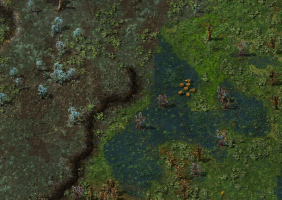Gleba: Difference between revisions
Iridium235 (talk | contribs) →Biomes: Added extra information to this section |
→Biomes: More details including soil placement. |
||
| Line 50: | Line 50: | ||
|} | |} | ||
===Biomes=== | === Biomes === | ||
Gleba hosts multiple biomes. | Gleba hosts multiple biomes. | ||
;Deep water | ; Deep water lake | ||
: | : A region of deep water that is impassable without [[landfill]]. | ||
; | ; Blue marsh | ||
: | : An area of shallow water with some buildable terrain, typically bordering deep water lakes. Does not contain any farmland. | ||
;Green | ; Midlands | ||
;Red | : Turquoise or orange terrain with no marshlands, suitable for building without needing [[landfill]]. | ||
; Highlands | |||
: Darker terrain suitable for building without needing [[landfill]]. [[Stone]] can be found in this biome. | |||
; Green biome | |||
: Marshy terrain where [[Yumako tree]]s can grow. Contains a small amount of natural [[Yumako]] soil, a larger quantity of yumako wetlands where [[artificial yumako soil]] can be placed, and all other terrain in the biome can have [[overgrowth yumako soil]] placed on them. [[Copper stromatolite]]s can be found in this biome in abundance. | |||
; Red biome | |||
: Marshy terrain where [[Jellystem]]s can grow. Contains a small amount of natural [[Jellynut]] soil, a larger quantity of jellynut wetlands where [[artificial jellynut soil]] can be placed, and all other terrain in the biome can have [[overgrowth jellynut soil]] placed on them. [[Iron stromatolite]]s can be found in this biome in abundance. | |||
Pentapod enemies can only build nests on shallow water tiles, so midlands and highlands act as natural barriers to their expansion (artificial barriers can be made as well via [[landfill]] or similar tiles). | |||
== Mechanics == | == Mechanics == | ||
Revision as of 16:45, 12 December 2024
| This article is a stub, and not comprehensive. |
|---|
| You can help this wiki by expanding it. |
![]() Space Age expansion exclusive feature.
Space Age expansion exclusive feature.
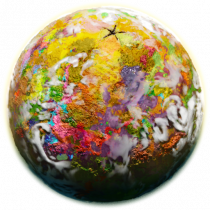
Gleba is a moist, agricultural planet with fungal hills and swampy lowlands.
It is home to the pentapods![]() , which are spider-like enemies who are attracted to the scent of biological processing called Spores, similar to the way that Nauvis creatures negatively respond to pollution. One of the most prominent traits of Gleba is that nearly everything takes a biological form.
, which are spider-like enemies who are attracted to the scent of biological processing called Spores, similar to the way that Nauvis creatures negatively respond to pollution. One of the most prominent traits of Gleba is that nearly everything takes a biological form.
Planet discovery Gleba (research) is required to travel to the planet.
Exclusive Items
The following items are unlocked on Gleba and can only be crafted on-planet:
- Agricultural science pack
- Artificial jellynut soil
- Artificial yumako soil
- Overgrowth jellynut soil
- Overgrowth yumako soil
- Biochamber
The following items are unlocked on Gleba but can be crafted elsewhere:
- Agricultural tower
 (Buildable only on Gleba and Nauvis)
(Buildable only on Gleba and Nauvis) - Captive biter spawner
 (spawners can be captured with Gleba's Capture bot rocket, constructed with Aquilo research, and exclusively produced and placed on Nauvis).
(spawners can be captured with Gleba's Capture bot rocket, constructed with Aquilo research, and exclusively produced and placed on Nauvis). - Heating tower

- Biolab
 (unlocked with Gleba science, but exclusively produced and placed on Nauvis)
(unlocked with Gleba science, but exclusively produced and placed on Nauvis) - Rocket turret

- Spidertron
- Stack inserter

- Toolbelt equipment

- Productivity module 3
- Efficiency module 3
Surface
Properties
| Property | Value |
|---|---|
| Pollutant Type | Spores |
| Day Night Cycle | 10 Minutes |
| Magnetic Field | 10 |
| Solar Power | 50% |
| Pressure | 2000 |
| Gravity | 20 |
Biomes
Gleba hosts multiple biomes.
- Deep water lake
- A region of deep water that is impassable without landfill.
- Blue marsh
- An area of shallow water with some buildable terrain, typically bordering deep water lakes. Does not contain any farmland.
- Midlands
- Turquoise or orange terrain with no marshlands, suitable for building without needing landfill.
- Highlands
- Darker terrain suitable for building without needing landfill. Stone can be found in this biome.
- Green biome
- Marshy terrain where Yumako trees can grow. Contains a small amount of natural Yumako soil, a larger quantity of yumako wetlands where artificial yumako soil can be placed, and all other terrain in the biome can have overgrowth yumako soil placed on them. Copper stromatolites can be found in this biome in abundance.
- Red biome
- Marshy terrain where Jellystems can grow. Contains a small amount of natural Jellynut soil, a larger quantity of jellynut wetlands where artificial jellynut soil can be placed, and all other terrain in the biome can have overgrowth jellynut soil placed on them. Iron stromatolites can be found in this biome in abundance.
Pentapod enemies can only build nests on shallow water tiles, so midlands and highlands act as natural barriers to their expansion (artificial barriers can be made as well via landfill or similar tiles).
Mechanics
- Main article: Spoilage mechanics
Most biological products on Gleba are "spoilable". A spoilable item has an inherent timer attached to it, which begins at the item's creation. When the timer reaches 0, the item is transformed into spoilage,![]() with a few exceptions. This process is inevitable and cannot be stopped.
with a few exceptions. This process is inevitable and cannot be stopped.
The exact time differs per item, ranging anywhere from a few minutes to 2 hours. This means that item throughput is more important than ever on Gleba, and buffering a large stockpile is ineffective, as items can spoil within containers.
The Biochamber, Gleba's special production building, uses a fuel source, nutrients. Nutrients also can spoil, and have a short, 5 minute spoil time.
Access to basic resources
- Water is readily available using offshore pumps
- Stone can be mined from patches on the surface as normal
- Iron ore can be obtained from Iron bacteria, which can be cultivated in a Biochamber using Iron bacteria cultivation
- Copper ore can be obtained from Copper bacteria, which can be cultivated in a biochamber using Copper bacteria cultivation
- Coal can be obtained via Coal synthesis
- Crude oil is not available. However:
- Plastic bars can be obtained from Bioplastic
- Sulfur can be obtained from Biosulfur
- Lubricant can be obtained from Biolubricant
- Rocket fuel can be obtained from Rocket fuel from jelly
- Heavy oil can be obtained using Coal liquefaction, if the initial heavy oil is shipped in from another planet. This is only really useful for flamethrower turrets, since all other oil products can be obtained more efficiently using the bio recipes.
Space routes
Gleba is connected to 4 other planets: Nauvis, Vulcanus![]() , Fulgora
, Fulgora![]() , and Aquilo
, and Aquilo![]() .
.
| Planet | Distance (km) |
|---|---|
| Nauvis | 15,000 |
| Vulcanus |
15,000 |
| Fulgora |
15,000 |
| Aquilo |
30,000 |
Asteroid rate graphs:
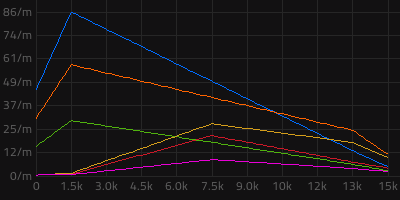 Space route from Nauvis to Gleba |
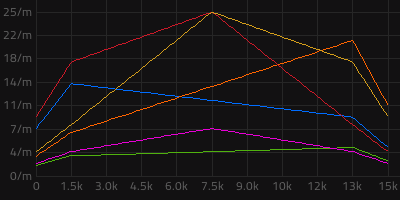 Space route from Vulcanus to Gleba |
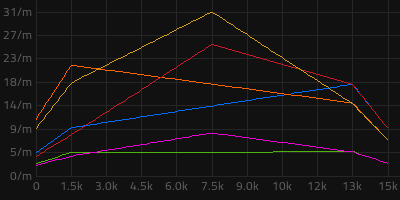 Space route from Gleba to Fulgora |
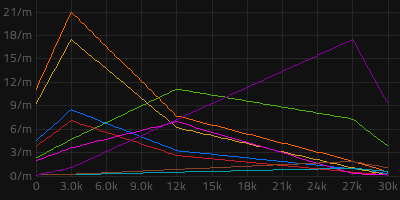 Space route from Gleba to Aquilo |
Graph legend:
| Asteroid type | Chunk | Medium | Big |
|---|---|---|---|
| ● Blue | ● Red | ● Cyan | |
| ● Orange | ● Yellow | ● Brown | |
| ● Green | ● Magenta | ● Purple |
Orbit
Properties
| Property | Value |
|---|---|
| Solar Power | 200% |
| Asteroid Type | Spawn Ratio |
|---|---|
| Metallic asteroid chunk | 2 |
| Carbonic asteroid chunk | 5 |
| Oxide asteroid chunk | 1 |
| Promethium asteroid chunk | 0 |
| Asteroid Size | Spawn % |
|---|---|
| Chunk | .30 |
| Medium | .25 |
| Big | 0 |
| Huge | 0 |
Note:
- Chunks spawn at Nauvis at 1.25%
- Huge Asteroids only spawn past Aquilo

Gallery
-
Example landscape of Gleba.
Trivia
- In biology, a gleba is a fleshy, spore-filled inner mass of some fungus like the puffball.
- During development, Gleba was once named Bacchus, after the Roman god of fertility, orchards, and vegetation.
